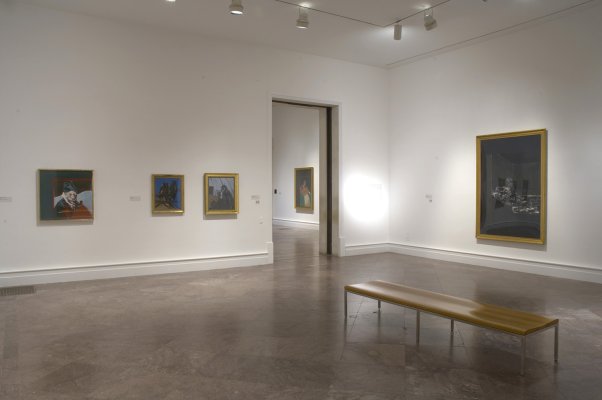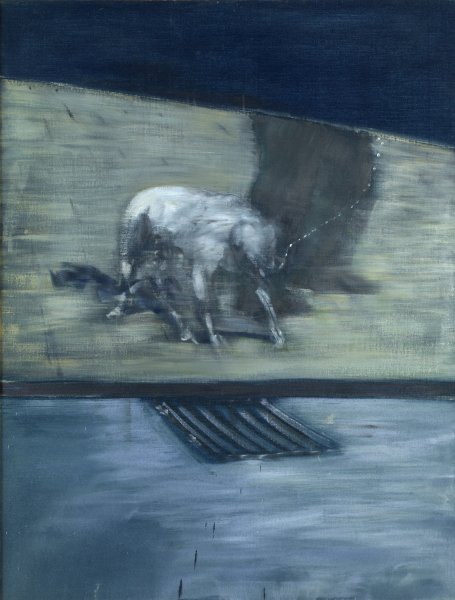Francis Bacon: Paintings from the 1950s
Friday, May 4, 2007–Sunday, July 29, 2007

Installation view of Francis Bacon: Paintings from the 1950s. Photograph by Tom Loonan.
1905 Building
Francis Bacon: Paintings from the 1950s focused on what was perhaps the most creative period of Bacon’s career. Curated by Michael Peppiatt, a personal friend of Bacon and author of the exhibition catalogue and a biography, this project is organized by the Sainsbury Centre for Visual Arts at the University of East Anglia, Norwich.
The exhibition was centered around a group of 13 paintings from the collection of Sir Robert and Lisa Sainsbury, prominent art collectors, patrons, and friends of Bacon. The Sainsburys were immediately attracted to Bacon’s treatment of the human form when they first encountered his work in the 1950s. The Sainsbury paintings, which date from 1952 to 1965, include a portrait of Robert Sainsbury and two of Lisa Sainsbury, who sat for Bacon numerous times and was his first female subject. The Sainsburys’ early and unwavering support of Bacon was a boon to his career.
In addition to the 13 Sainsbury paintings, there were other works from public and private collections around the world as well as archival materials, some of which had rarely been on view to the public. The museum’s own Man with Dog, purchased in 1953 by Seymour H. Knox, Jr., the same year it was painted and exhibited at Bacon’s first New York show, was also included.
Peppiatt met Bacon during the early 1960s when he was a student at Cambridge. Since then, Peppiatt has studied Bacon’s work and has identified the 1950s as the most formative phase of his career. Francis Bacon: Paintings from the 1950s highlighted the decade in which Bacon experimented with a wide range of complex themes and the haunting images that became his hallmark iconography—screaming heads, popes, caged animals, and distorted and isolated figures. Bacon was known for taking risks, not only in his art, but in his daily life as well. His life in the 1950s was consumed with destructive romantic relationships, gambling in Monte Carlo and Tangier, among other places, and general overindulgence of all kinds. A flamboyant homosexual with an appetite for danger and luxury, Bacon traveled in many social circles of extreme contrast—from a ritzy gathering at a four-star restaurant to gambling parties with vagrants. Experiencing and observing the human condition in its many guises was Bacon’s forte, and he set out to expose the visceral content he envisioned behind social and emotional veils.
Bacon made ambitious strides during the 1950s. His work from this period has a raw sense of immediacy. Provocative and mysterious, it reflects a variable and creative mind unbound by social and artistic conventions.
In conjunction with this exhibition, exhibition curator Michael Peppiatt gave a talk about the life and work of Francis Bacon at the museum on May 4, 2007.
Exhibition Sponsors
This exhibition was initiated by the Sainsbury Centre for Visual Arts at the University of East Anglia, Norwich, UK, with funding from the Robert and Lisa Sainsbury Charitable Trust. It was curated by Michael Peppiatt, who is also the author of the exhibition catalogue.
This exhibition was made possible in Buffalo through the generous support of M&T Bank with additional support from an indemnity from the Federal Council on the Arts and Humanities.
This exhibition was initiated by the Sainsbury Centre for Visual Arts at the University of East Anglia, Norwich, UK, with funding from the Robert and Lisa Sainsbury Charitable Trust. It was curated by Michael Peppiatt, who is also the author of the exhibition catalogue.
This exhibition was made possible in Buffalo through the generous support of M&T Bank with additional support from an indemnity from the Federal Council on the Arts and Humanities.
